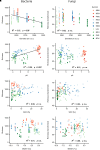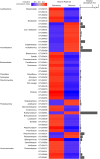The Soil Microbiome of GLORIA Mountain Summits in the Swiss Alps
- PMID: 31156590
- PMCID: PMC6529532
- DOI: 10.3389/fmicb.2019.01080
The Soil Microbiome of GLORIA Mountain Summits in the Swiss Alps
Abstract
While vegetation has intensively been surveyed on mountain summits, limited knowledge exists about the diversity and community structure of soil biota. Here, we study how climatic variables, vegetation, parent material, soil properties, and slope aspect affect the soil microbiome on 10 GLORIA (Global Observation Research Initiative in Alpine environments) mountain summits ranging from the lower alpine to the nival zone in Switzerland. At these summits we sampled soils from all four aspects and examined how the bacterial and fungal communities vary by using Illumina MiSeq sequencing. We found that mountain summit soils contain highly diverse microbial communities with a total of 10,406 bacterial and 6,291 fungal taxa. Bacterial α-diversity increased with increasing soil pH and decreased with increasing elevation, whereas fungal α-diversity did not change significantly. Soil pH was the strongest predictor for microbial β-diversity. Bacterial and fungal community structures exhibited a significant positive relationship with plant communities, indicating that summits with a more distinct plant composition also revealed more distinct microbial communities. The influence of elevation was stronger than aspect on the soil microbiome. Several microbial taxa responded to elevation and soil pH. Chloroflexi and Mucoromycota were significantly more abundant on summits at higher elevations, whereas the relative abundance of Basidiomycota and Agaricomycetes decreased with elevation. Most bacterial OTUs belonging to the phylum Acidobacteria were indicators for siliceous parent material and several OTUs belonging to the phylum Planctomycetes were associated with calcareous soils. The trends for fungi were less clear. Indicator OTUs belonging to the genera Mortierella and Naganishia showed a mixed response to parent material, demonstrating their ubiquitous and opportunistic behaviour in soils. Overall, fungal communities responded weakly to abiotic and biotic factors. In contrast, bacterial communities were strongly influenced by environmental changes suggesting they will be strongly affected by future climate change and associated temperature increase and an upward migration of vegetation. Our results provide the first insights into the soil microbiome of mountain summits in the European Alps that are shaped as a result of highly variable local environmental conditions and may help to predict responses of the soil biota to global climate change.
Keywords: GLORIA; alpine; bacteria; climate change; fungi; mountain summit; soil.
Conflict of interest statement
The authors declare that the research was conducted in the absence of any commercial or financial relationships that could be construed as a potential conflict of interest.
Figures







Similar articles
-
Local Environmental Factors Drive Divergent Grassland Soil Bacterial Communities in the Western Swiss Alps.Appl Environ Microbiol. 2016 Oct 14;82(21):6303-6316. doi: 10.1128/AEM.01170-16. Print 2016 Nov 1. Appl Environ Microbiol. 2016. PMID: 27542929 Free PMC article.
-
High-Alpine Permafrost and Active-Layer Soil Microbiomes Differ in Their Response to Elevated Temperatures.Front Microbiol. 2019 Apr 3;10:668. doi: 10.3389/fmicb.2019.00668. eCollection 2019. Front Microbiol. 2019. PMID: 31001236 Free PMC article.
-
Vegetation trends over eleven years on mountain summits in NW Argentina.Ecol Evol. 2018 Nov 14;8(23):11554-11567. doi: 10.1002/ece3.4602. eCollection 2018 Dec. Ecol Evol. 2018. PMID: 30598756 Free PMC article.
-
The Impact of Artificial Restoration of Alpine Grasslands in the Qilian Mountains on Vegetation, Soil Bacteria, and Soil Fungal Community Diversity.Microorganisms. 2024 Apr 25;12(5):854. doi: 10.3390/microorganisms12050854. Microorganisms. 2024. PMID: 38792684 Free PMC article. Review.
-
Alpine and subalpine plant microbiome mediated plants adapt to the cold environment: A systematic review.Environ Microbiome. 2024 Nov 1;19(1):82. doi: 10.1186/s40793-024-00614-0. Environ Microbiome. 2024. PMID: 39487507 Free PMC article. Review.
Cited by
-
Distinct microbial communities across a climatically versatile summit in the Lesotho highlands.Ecol Evol. 2023 Mar 15;13(3):e9891. doi: 10.1002/ece3.9891. eCollection 2023 Mar. Ecol Evol. 2023. PMID: 36937054 Free PMC article.
-
Impact of Climate and Slope Aspects on the Composition of Soil Bacterial Communities Involved in Pedogenetic Processes along the Chilean Coastal Cordillera.Microorganisms. 2022 Apr 20;10(5):847. doi: 10.3390/microorganisms10050847. Microorganisms. 2022. PMID: 35630293 Free PMC article.
-
Elevational changes in the bacterial community composition and potential functions in a Tibetan grassland.Front Microbiol. 2022 Nov 10;13:1028838. doi: 10.3389/fmicb.2022.1028838. eCollection 2022. Front Microbiol. 2022. PMID: 36439816 Free PMC article.
-
The Characterization of Microbiome and Interactions on Weathered Rocks in a Subsurface Karst Cave, Central China.Front Microbiol. 2022 Jun 29;13:909494. doi: 10.3389/fmicb.2022.909494. eCollection 2022. Front Microbiol. 2022. PMID: 35847118 Free PMC article.
-
Effect of elevation on composition and diversity of fungi in the rhizosphere of a population of Deyeuxia angustifolia on Changbai Mountain, northeastern China.Front Microbiol. 2023 Apr 20;14:1087475. doi: 10.3389/fmicb.2023.1087475. eCollection 2023. Front Microbiol. 2023. PMID: 37266006 Free PMC article.
References
-
- Barry R. G. (2008). Mountain Weather and Climate 3rd Edn. New York, NY: Cambridge University Press.
-
- Barton H. A., Giarrizzo J. G., Suarez P., Robertson C. E., Broering M. J., Banks E. D., et al. (2014). Microbial diversity in a Venezuelan orthoquartzite cave is dominated by the Chloroflexi (Class Ktedonobacterales) and Thaumarchaeota Group I.1c. Front. Microbiol. 5:615. 10.3389/fmicb.2014.00615 - DOI - PMC - PubMed
-
- Bridge P. D., Newsham K. K. (2009). Soil fungal community composition at Mars Oasis, a southern maritime Antarctic site, assessed by PCR amplification and cloning. Fungal Ecol. 2 66–74. 10.1016/j.funeco.2008.10.008 - DOI
LinkOut - more resources
Full Text Sources

